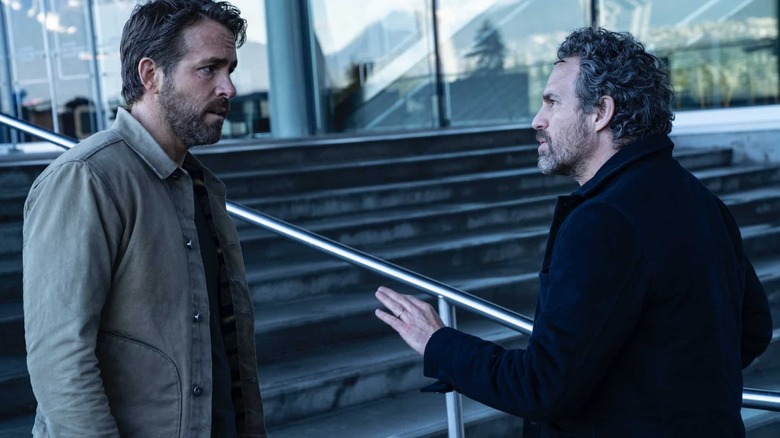Don't Ask Shawn Levy How Time Travel Works In The Adam Project
To be reductive, there are two schools of thought on time travel stories.
There is the Apollonian approach to time travel stories, which bothers to think out the mechanical fineries of causality, and concerns itself with the differences between causality and determinism (from a character arc standpoint). Examples of this are "Primer," "Predestination," "Back to the Future," "Donnie Darko," and "Planet of the Apes." These are stories that appeal to the intellect.
Then there is the Dionysian approach to time travel stories, which ignores the fineries of causality, physics, and even basic time to communicate a parable. What if you met yourself from another time? If you could go back in time and murder a fascist before they became a criminal, would you? Examples are "Bill and Ted's Excellent Adventure," "Avengers: Endgame," "Men in Black 3," and Shawn Levy's new film "The Adam Project." These are stories that appeal to the emotions.
In a recent interview with Uproxx, Levy explained that a complicated, rules-explaining time travel story was of no interest to him, preferring to tell a more emotionally satisfying one. When interviewer Mike Ryan asked Levy about how much fun it would be to cover the rules of time travel with his star Ryan Reynolds, he gave a surprising answer: "Well, I'm going to surprise you," he said. "To me, that sounds like the opposite of fun."
Simplify, simplify
The story of "The Adam Project" follows a time-traveling pilot named Adam (Ryan Reynolds) from the year 2050 back in time to 2022 where he teams up with his wonderstruck 12-year-old self (Walker Scobell) to confront a wicked businesswoman (Catherine Keener), reunite with his time-traveling wife (Zoe Saldaña), and go back to 2018 to meet their dead father (Mark Ruffalo).
Levy wasn't interested in science of any of that.
Because even though I am now the director of a time travel, sci-fi adventure, my interest in time travel mythology and science rules is minimal. I am an emotional filmmaker. I want my movies to connect emotionally. So literally my whole goal with "The Adam Project" was the simplest, most concise declaration of rules possible.
Levy trusted his screenwriters to take care of the finer points of time travel, and when they got too complicated, Levy insisted on simplicity. There still needed to be rules, of course, but the rules only needed to be understood on a very rudimentary level. Says Levy:
It's still rules. And you know what? Here's why I'm lucky. Jonathan Tropper and Don Granger at Skydance spent eight years developing the script. I understood about 78 percent of it. To quote Taika Waititi in my movie "Free Guy," "Pretend I'm dumb." I said, "Tropper, pretend I'm dumb. Tell me the rules." He explained it to me in layman's terms. And I said, "Okay, use those words in the screenplay," because I don't want the movie to feel like homework. I want it to feel soundly constructed but digestible so that the audience could just connect with the characters.
Using real-life confusion
Indeed, Levy admits that his own confusion about the way time travel works was an important creative tool in shaping the screenplay. If something strange came up, he would begin grilling the film's screenwriters, and some of their conversations became dialogue:
There's a scene outside the cabin where Zoe Saldaña is talking about how there was a time jet that came back from a certain timestream, but there was no record of it having left. And literally I said to Tropper, "Wait, how was there a record of it if it never left?" And Tropper said because the timestream from which it left had already been changed. And I literally said, "Wait a second. This is convenient. I have one character who's not so bright, and I've got the little 12-year-old kid who's a brainiac. So why don't you write the dialogue that you and I, director and screenwriter, just had and put it in the mouths of the characters?" So I always find that's a useful trick, to literally name the explanation by using it as dialogue.
This seems like a wise approach, as it would permit the filmmakers to stay one step ahead of the conversations the audience may be having after the movie. It's also a handy screenwriting trick to include a character that needs to have an fantastical world or fantasy conceit explained to them, as it serves the function of informing the character and the audience simultaneously. According to Levy, it's doubly handy when you have two Ryan Reynoldses in your movie who can sarcastically give each other grief for their respective ignorance:
It is very helpful when you have a character in the narrative who can be the mouthpiece of explanation. It also helps when you have a young Ryan Reynolds character who can give s*** to Ryan Reynolds. So in that same scene, I wrote a line where Walker looks at Ryan and says, "It's like I traded in my brains for those muscles." And then Ryan improvised the line for Walker on the shooting day where he adds, "That's a s*** deal." That's very much how we work. We work on the script, and then we add, and then we add, and then we add, and then we add while we're making the thing.
"The Adam Project" is streaming on Netflix now.


